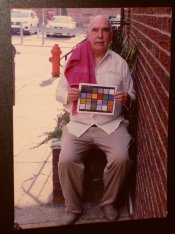- Joined
- Aug 22, 2006
- Messages
- 1,515
- Format
- Multi Format
The problem with colour crossover is that without a rigorous route to examine and test the truth of whether it exists or not in a negative ...
Well, it's more complicated because it can't really exist alone in a negative. A negative on its own doesn't make an accurate color reproduction; its an intermediate recording of an image. So one has to define a system. Now in my world, which is largely the world of physical prints, the test for good color reproduction is to photograph something (under a "proper" light source, whatever that may be), then develop the film and make optical prints. I say "optical prints," meaning via an enlarger because that's how these systems were originally designed. There is a delicate balance between how the film "sees" a colored object and how that film forms dyes to represent that object, and then how an enlarger's light source, after passing through the dyes in that film (plus the filters used for color-balancing) affect the printing paper, which has its own set of spectral responses and resulting dyes. Then you look at the print, also under a "proper" sort of light, then decide if it is a decent representation of the color of the original object.
Now if you can succeed at this, then I would say that you have made a decent color reproduction.
I should note that this likely only works "perfectly" under one type of light source; because the original object probably has a different spectral makeup than the print. It is generally possible to "trick" our eyes, under a specific spectral makeup of light, to see the original and the print as nearly identical. (This known as a metameric match.) But... if the light source is changed, then likely the apparent match is gone. (You may have noticed this sort of thing where you pick out some clothes in a department store, but when you get out in the daylight they no longer match.)
Anyway, let's say that you have gotten a fairly decent color reproduction using the combination of film and paper. And this reproduction holds up under a wide range of scene brightness values. So I would say that the "system" was successful. Neither the film nor paper was able to stand alone, but combined, and under the proper conditions, they made a decent color reproduction.
Now let's say that we have screwed up this finely tuned system by making the film behave differently. Say that we now make a print, but we are not able to have, for example, the gray tones stay neutral throughout the brightness range. If you have the specific situation that it "wants" a certain color-correction in the light areas but an opposite (or complementary) color in the dark areas, then this is called a color cross. This is what would happen if you could make the film change its contrast in only one dye layer. And it's not correctable by "normal" means.
Now earlier I suggested that neither the film nor paper can stand alone, that one has to judge their combined effect. But... given that the hypothetical earlier system DID give a decent color reproduction I think that it's fair to say that, since we specifically screwed up this hypothetical film, that the film itself has induced the color crossover. It certainly could be possible to build a special companion paper that exactly counteracts the "bad" aspect of the hypothetical screwed up film, and then there would be no color cross from the "system." But as a general rule the manufacturers have not done fine tuning of papers to match oddball film responses. Papers tend to be generally somewhat interchangeable, at least within the amateur realm and within the professional realm.
Earlier I defined a "system" as the combination of film and paper; it's just my personal baseline, for various reasons. Someone else might define it as scanned film, and if the combination doesn't give good color reproduction then there might be some ambiguity as to which one is the source of the problem. Using the base reference that I prefer, the ability to make a good print on photo paper, can reveal whether or not the negative conforms to a presumed design aim. If it DOES conform (by making a good quality print) then I would judge the negative to be ok, and that therefore the problem must be in the scanning step.







